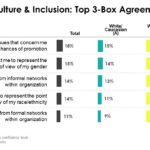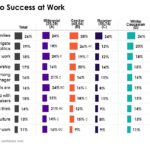
On the tailwinds of the Black Lives Matter movement, the Women’s March and the overall continued efforts for diversity and inclusion, the base case for advancing women and colleagues with diverse experiences within the financial services industry is clear. With this base case well-known, we must be more proactive and intentional to significantly improve workplace diversity. It is equally, if not more, important to recognize that not all women have similar experiences in the industry or encounter the same barriers.
I can’t expect that my experiences as a woman represent the same experiences of every woman in financial services. Nor should I (and we) expect the same of other women colleagues. Some may have positive stories to share while others may be experiencing a disproportionate burden of inequities and pressure in the industry. But the more we encourage conversation on intersectionality and allow colleagues to share their experiences, the better-off our industry will be. This goes for both our own personal work culture within financial services as well as our research to improve the industry.
“From a cultural standpoint, I think our firm is trying very hard to make changes towards greater diversity and inclusion. However, it takes time. But I think the sincere interest and effort is there and the firm will continue to make progress towards a greater future state.” — Working in an Asset Management Firm, GenXer, White/Caucasian
Last fall, WIPN and Escalent embarked on a first-of-its-kind assessment of the attitudes, experiences, behaviors and compensation of women in the retirement industry. To start the all-important conversations on diversity in financial services, in our research with WIPN, we asked women in the retirement industry about their perceptions and experiences. Here’s some of what we found.
Women of color often feel the need or feel pressured to alter their behavior, appearance or communication style in their work environment more than non women color in order to feel accepted or aligned with workplace norms.
- Women of color, particularly Black and Hispanic/LatinX women, are more likely than their peers that are not women of color to agree that their firm expects them to represent the point of view of their race and/or ethnicity. While this should not be an expectation nor is it a requirement in their job description, it is evident that many women of color experience this frequently.
- Unsurprisingly, women of color express higher levels of dissatisfaction than white women in important areas in their career: work environment/culture, level of seniority achieved, industry expertise, and workplace inclusion.
“I reached out to my manager at the very beginning of the year to make sure I was on track with my goals and objectives. She was very dismissive and was very unhelpful.” — Working in a Consulting or Advisory Firm, Black/African-american millennial

Feelings of success and barriers to feeling successful differ for women by age.
Boomer women feel most successful when they are recognized and appreciated within their work environment. And while Boomer women have likely worked hard to find a work culture they thrive in, there still must be a way for younger women to love where they are in their career.
- GenX women are least likely to have high satisfaction in their career role performance. They cite the inability to navigate workplace politics and low visibility of their work as areas where a mentor could help them.
- Compared with women in other generations, Millennial women consider their biggest barriers to success as being uncertain of what their goals are, caring too much about what others think and lacking resources that can help them navigate their careers.
- Millennial women, similar to women of color, are changing their behavior, appearance and communication style more so than the women of other generations.


“My manager is competitive and will not advocate for me …. Although I merit a promotion and raise based on contributions and analysis and problem-solving, my professional weaknesses are my soft skills, such as presence, confidence and persuasive communication skills. I am working on my soft skills, and will need to change companies since my manager is not supportive.” — Working in a Private Bank/Trust Company, Asian GenXer
What Can You Do?
Approaching our work and workplace culture with a lens for intersectionality should not be a “do if you can” scenario. Rather it should be an integrated part of strategic planning at all levels. So, you may ask, “what can I do?” I won’t pretend to have all the answers as I am still learning myself, but you could:
- Seek out diverse stories. Be an active participant in conversations in your organization with those who have lived different experiences than you. And if no conversations exist, you can help start them by creating a diversity, equity and inclusion council or hosting regular luncheons. While HR should have an active role in recruiting and retaining diverse candidates, it shouldn’t end with them. Your conversations with colleagues matter and are one way to learn about the experiences of others in your workplace and industry. You may find that your projects end up stronger when you intentionally engage with those who don’t think and don’t act like you.
- Find reading materials, podcasts and movies to educate yourself on what you can do with your time and resources. One of my goals is to focus this on informing better research standards and broadening the horizons on what we are asking advisors and other financial professionals. Perhaps advisors are producing widespread materials that use red and green colors indiscernible to those who are color-blind. Or we discover we are leveraging a technology developed for everyone but tested only by those with advanced degrees. You don’t know what you don’t know.
- Hold your firm accountable. Fewer than half of women rate their company well for actively recruiting diverse talent, so ask your leaders and hiring teams what they are doing in this area and if their strategy is working. The strategy doesn’t need to impose quotas, but there can still be goals set that are regularly and transparently discussed.
- Ensure that any research you work on actively recruits diverse respondents. And if a diverse pool is not large enough, take the extra step to have a qualitative research lens and you may find participants whose story is worth the time to make your research better. As researchers, we should view it as mission critical to elevate the voices of those who otherwise might not be heard.
“I am proud to work for a company that believes in diversity and inclusion …. More than 65% of the leadership at my company is female and diverse—I don’t have to think about this. It is refreshing to hear comments at finals presentations when people notice the diversity in the presentation team. We don’t have to think about this, is what happens when diversity is achieved.” — Working for a Retirement Plan Provider, Boomer, Hispanic/LatinX
With only about half of women in the retirement industry rating their company positively for fostering a culture of equity and inclusion, there is clearly work to be done. Our research practices within financial services are not excluded from this call to action. While the task to obtain true, represented diversity can be daunting, the worst thing we can do is to do nothing, as the choice to be inactive is still an action.
For a deeper look at the attitudes and behaviors of women in the retirement industry, download our joint white paper with WIPN, What’s Working at Work.








